Sweet Pea and Fava Crostini with Herbs and Ricotta
More with Pace da Poggio Etrusco Extra Virgin Olive Oil
The baby vegetables are in the Farmer’s Markets. The herb garden is planted, and tiny peas in their pods have made an appearance. My mint plants are already giving forth, their new leaves packed with fresh flavor. Spring has arrived, and with it have come the fava beans.
Travails with Fave or Size Does Matter
Preparing fave (FAH-vay, plural of fava) is a labor or love, or so some people say. The preparation of this member of the Fabaceae (bean family) is a point of great contention among the cooking community and for a time, a source of plunging self-esteem for me. To peel or not to peel? That is the question. The Great Fava Bean Debate of 2013 rages on. For years I labored (or not, depending on one’s point of view) in blissful ignorance of the aforementioned debate, happily zipping open the fava pods, removing the tiny beans from their downy resting spots and eating them. For me there was no third step. You know the one, the part where you peel the beans.
In the garden or at the market I selected firm, bright green pods, free of marks or blemishes. Patient harvesting or careful shopping rewarded me with tiny beans, sweet and tender, about the size of my little fingernail. I never bothered with the larger beans, having always thought them better suited to the compost heap than a diner’s stomach.
However there came a point at which I realized that everyone, food writers and friends alike, even food writing friends, was talking about peeling the fave. A terrible unease set in, the kind of self-doubt in which I specialize. Could I possibly be so rustica, so out of touch with civilized culinary technique? It seemed that everyone peeled those little beans before consuming them, whether raw or cooked. Then one day just a few weeks ago I was rescued from the ignominy of bean preparation inadequacy by none other than food writer Nancy Harmon Jenkins. She came down on the side of not to peel. Despite some formidable opposition, chief among them Paula Wolfert, Nancy stuck to her guns. There is no need to peel, she declared. It is simply a matter of knowing how to pick fave, and you should pick them young. Thanks, Nancy. A girl needs her heroes.
Fava, Baby Pea and Ricotta Crostini
makes about 14, depending on width of loaf
I’ve still been experimenting and enjoying Pace da Poggio Etrusco Olive Oil made by American expat food writer Pamela Sheldon Johns at her home in Montepulciano, Tuscany. The oil is among a selection I received for review from Olio2go, one of the nation’s largest retailers of Italian extra virgin olive oils. The swanky oil’s herbal notes and fresh fruity flavor marry beautifully with this eye-catching antipasto, lifting the flavors and lending a succulence that is nothing short of amazing. A touch of pizzico (the prized burn at the back of one’s throat) makes this a sensational start to a spring meal.
If you can not find fave, use peas. You may wish to increase the lemon juice slightly, however. Taste and check, adding a bit more juice, ¼ teaspoon at a time, if you find the topping too sweet.
This mixture is also great tossed with spaghetti. Add a tablespoon or two extra of Pace da Poggio Etrusco olive oil to loosen it a bit. Combine with the hot spaghetti, adding ¼ cup of pasta water at a time, tossing until the spaghetti is well coated. Top with more chopped herbs and a drizzle of Tuscan oil. Grate Pecorino over the dressed pasta and serve.
baguette or country bread, sliced on bias into pieces about ⅜ inch thick
4 oz. small shelled fava beans (about 8-9 oz. in their pods)
4 oz. young green peas, frozen or fresh
¾ cup whole milk ricotta cheese
1 tablespoon chopped mint
2 tablespoons chopped basil
1-2 teaspoons fresh lemon juice
shaved Pecorino Toscano OR Pecorino Romano cheese
2 garlic cloves, peeled and cut in half lengthwise
Pace da Poggio Etrusco Extra Virgin Olive oil
kosher salt and black pepper, to taste
Shell the beans by bending the tip and unzipping the pod to expose the interior and the beans. Remove the beans and discard the pod.
Peel if you must. See Food Nerd Notes for three methods.
Unless the beans and the peas are quite small and tender, I cook them briefly. Fill a 4-quart saucepan half full with water. Bring to a boil over high heat. Reduce to a simmer, add the beans and boil gently until tender, about 3 to 5 minutes. Cooking time will vary depending on the size of the beans. Just before the fave are done, add the peas to the saucepan and boil for 30 seconds. Transfer the fave and peas to a bowl of ice water to stop the cooking. Drain and set them on towels to dry.
Reserve 2 tablespoons of whole peas to garnish the crostini. Coarsely chop the fave and peas together and transfer to a medium bowl. Add the ricotta, chopped herbs, ½ teaspoon lemon juice, ¼ teaspoon each of kosher salt and black pepper, and 2 tablespoons of Pace da Poggio Etrusco oil. Stir gently to blend. Check for seasoning, adding more salt, pepper or lemon juice, if desired.
Preheat a grill pan for 5 minutes over medium heat. Grill the bread slices until warm and very lightly marked on both sides. As the bread is heating, peel the garlic cloves and cut them in half lengthwise. Remove the bread from the grill pan, and rub one side lightly with the cut garlic. Lightly drizzle olive oil over the garlic rubbed side of the bread.
Spread the ricotta mixture on the garlic rubbed surface of each piece of bread, leaving a few indentations on the surface of the ricotta. Arrange the crostini on a serving plate. Top each piece with a few of the reserved peas, pressing them in gently. Drizzle lightly with olive oil, letting a bit of oil pool in the indentations. Use a vegetable peeler to shave Pecorino Toscano over the crostini. Serve.
Food Nerd Notes: Here are three methods for peeling fave. The first comes courtesy of Ciao Chow Linda. Place the beans on a sheet pan and freeze for 8 to 10 minutes. Remove the beans from the freezer, and pull off and discard the outer skin. If the skin does not slip off easily, let the beans defrost a moment, and success will be yours. Click to see Linda’s photo essay and to see her take on a fava bean antipasto.
The second method is to drop the beans into boiling water for 1 to 4 minutes (opinions vary) during which time their skins will loosen. Remove the beans from the boiling water and plunge them into a bowl of ice water to shock them and stop the cooking. Remove the beans from the ice water. The outer skin can now be easily removed, and the beans are ready to eat raw or cook further.
The third method is to drop the entire pod, still containing the beans, into boiling water and boil for 1 to 2 minutes. Transfer the pods to an ice water bath to shock them and stop further cooking. Remove the pods from the ice water. Zip open the pods and remove the beans. Remove the skins.
Click to visit Erica de Mane and read of her travails with fave, find out where she comes down in the Great Debate and get her recipe for Fava, Chicory and Tarragon Salad.
Pace da Poggio Etrusco Extra Virgin Olive Oil is available online from Olio2go, 8400 Hilltop Road, Suite H, Fairfax, VA 22031 866-Olio2go (866-654-6246) It is supplied in 500 ml. stainless steel tins. The cost is $32.95, plus shipping.
Note: You can click on any picture for a slide show!
Disclosure: I received the product mentioned above for free. I only recommend products or services I use personally and believe will be good for my readers. I otherwise have no affiliation with any product, manufacturer, or site mentioned in this article.
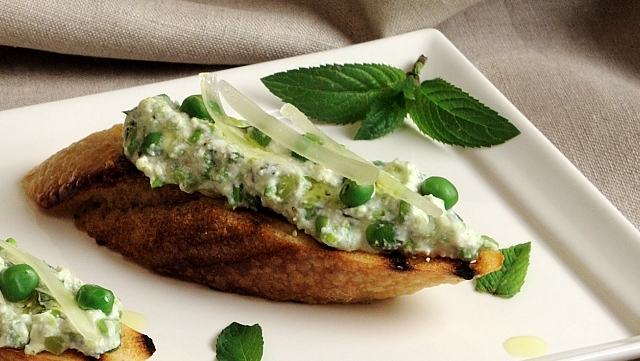
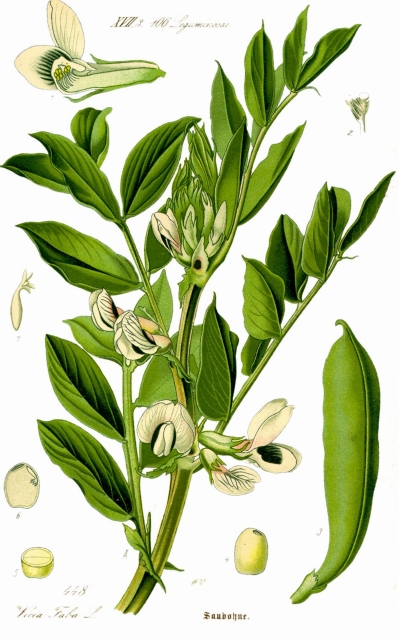
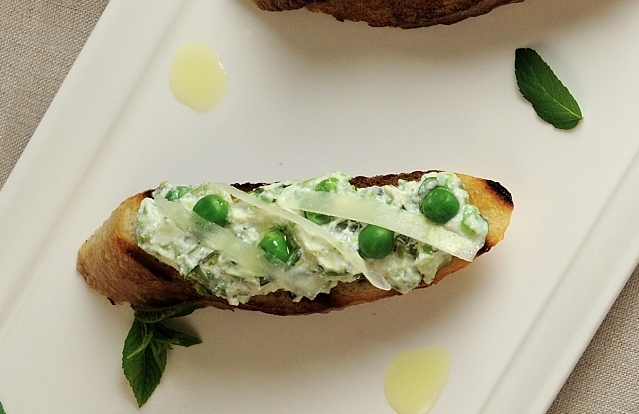
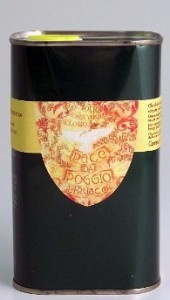
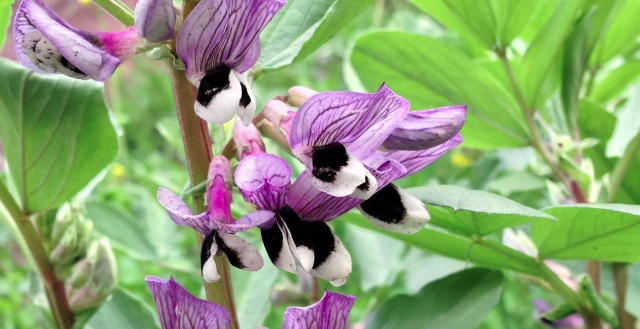

Monday, May 13th 2013 at 1:46 am |
Adri, I never realized that there existed a discussion as to peeling or nor peeling fava beans – I always learn something new when I visit your lovely blog – but I do know that fava beans do not enjoy a large fan following in this country. Your recipe should prove to all the no fava bean eaters how very delicious they can be when harvested young, chosen carefully in the market and prepared with as much dedication as you do in this wonderful recipe!
Great post, Adri – I so enjoyed reading it and looking at the pictures! Have a wonderful Monday!
Monday, May 13th 2013 at 6:05 am |
Hi Andrea,
Oh, it warms my heart to find another who knew nothing of The Great Debate! I feel less lonely already. Fave are definitely not mainstream food here in the U.S. Most markets do not carry them, and of those that do, their fave are often huge, with soft pods way past their prime. It is a pity, but not a big surprise as fave have a reputation for being a bit of work. They are gaining in popularity, but I’d have to say really only among those who enjoy Italian cuisine. Literally every day I see more recipes that call for them.
Monday, May 13th 2013 at 5:01 am |
Che meraviglia questi crostini, molto invitanti, deliziosi!!!!
Monday, May 13th 2013 at 6:18 am |
Ciao Simona,
Grazie. Questi crostini sono perfetti per la primavera!
Monday, May 13th 2013 at 6:16 am |
Yes, I’m loving the newly-appearing spring veggies at the farmer’s market and herbs in our herb garden, too. And what a perfect way to showcase both of those thing – delicious!
Monday, May 13th 2013 at 6:21 am |
Hi Amy,
These are tasty and will probably be a fine way to get your new family member to eat peas. I hope you are feeling great!
Monday, May 13th 2013 at 1:17 pm |
Adry carissima dai tuoi post imparo sempre molte cose, la tua ricetta è molto invitante la voglio proporre al mio piccolino! Un bacione dall’Italia!
Monday, May 13th 2013 at 10:10 pm |
Grazie, Mariangela. Un bacione a te!
Monday, May 13th 2013 at 1:52 pm |
I love fava beans so I will be making these to go with cocktails tonight. I hope mine come out a nice looking as your photos
Monday, May 13th 2013 at 10:12 pm |
Ciao Antonio!
So Mr. Fama loves the fava. I am glad to hear it. Enjoy!
Monday, May 13th 2013 at 2:45 pm |
Adri – Thanks for the shout-out. I think I peel my favas because the selection at the stores where I live is dismal – they’re all too large really. If I could get them tiny I’d skip the peeling altogether too. Your bruschetta looks like the perfect vehicle for both the fava beans and Pamela’s olive oil.
Monday, May 13th 2013 at 10:14 pm |
Hi Linda,
The shout-out was my pleasure entirely. I thought your freeze ’em and peel ’em technique was darn clever, and I was pleased to share it. I hear you about the large beans. Wow, but some of the fave in the markets here are practically Favazilla. Those babies hung on the vine way too long!
Tuesday, May 14th 2013 at 12:00 pm |
cara Adri, hai portato la primavera con questo post ! proverò questi crostini, sono molto invitanti ! Un abbraccio grande !
Tuesday, May 14th 2013 at 1:00 pm |
Ciao Chiara,
Grazie – davvero la primavera!
Tuesday, May 14th 2013 at 4:50 pm |
What a beautiful ode to spring! I recently made simply sauteed fava beans with spring onions and a good drizzle of oil. My oldest son – 7 years old and a terrific and open-minded eater – said that they had a “dark” taste. I loved his choice of adjective and had to agree. I wonder if they would have tasted “brighter” if I had peeled them. Will pick some up tomorrow and try it out!
Tuesday, May 14th 2013 at 7:55 pm |
Hi Michelle,
Thank you! I think you have a budding food writer at home. How wonderful that he is an open minded eater. Some kids are not. I bet it is fun to experiment with him.
Indeed the fave might taste brighter when peeled if they are not young. I love all the talk this subject has drawn. The Great Debate continues.
Wednesday, May 15th 2013 at 3:34 pm |
These look like the perfect spring appetizer! I don’t see fava beans that often here 🙁 Love the ingredient list.
Wednesday, May 15th 2013 at 4:58 pm |
Hi Susan,
Yes indeed – a seasonal antipasto. I don’t see fava beans here in Los Angeles a whole lot either. Each year more stores have them, but even at that, they tend to be old, and I don’t think that is doing much for their reputation! If you can not find any fave, use peas. This one is versatile!
Thursday, May 16th 2013 at 2:21 am |
TO PEEL OR NOT TO PEEL? I do not peel broad beans but…the beans must be picked young!!! My sister peels everything (even grape or tomatoes!!). I use as much as I can when eating vegetables/fruit. What a combo ricotta fave peas and a very good ex olive oil!! Il crostino primaverile….PS I bought the pancetta in Rome. That is the
‘standard’ Italian pancetta.
Thursday, May 16th 2013 at 6:56 am |
Hi Rita,
It is good to hear you are on the “buy them young and leave them alone” side of the Debate! Your sister peels grapes also! Wow – she is one very patient woman.
Rome – so that is where you got the pancetta. My, but it is just beautiful. Thank you for the info.
Saturday, May 18th 2013 at 9:42 am |
I’m loving the peel no peel conversation. GREG
Saturday, May 18th 2013 at 12:41 pm |
Hi,
Excellent! The topic certainly engendered strong feelings on both sides.
Friday, May 24th 2013 at 4:07 am |
Ottima questa ricetta e complimenti per tutto il blog!
Friday, May 24th 2013 at 11:54 am |
Grazie, Laura!
Tuesday, May 28th 2013 at 5:19 am |
I never peel fava beans if I can help it! I way too lazy. If there’s young and tender enough, there’s just no need. And if they’re not, well, I just don’t buy them. You can also buy pre-peeled (cooked) fava beans that are not half bad for dishes where you want them cooked and a firm texture is not an issue.
They crostino, by the way, looks fab. :=)
Tuesday, May 28th 2013 at 11:03 am |
Ciao Frank!
It’s good to meet anther non-peeler. It was funny that suddenly I became aware that so many cooks peeled the beans. I was sure I had missed some crucial bit of kitchen wisdom some where along the line. Thanks for the tip about the pre-peeled and cooked fave. I have not seen them, but will keep an eye open. I am glad you like the look of this dish; it is certainly an antipasto for spring.
Thursday, May 30th 2013 at 1:18 am |
OOOOHHH Adri, that crostino looks awesome!! I have no right to enter into the great fava bean peeling debate, but if I did, I know you can guess where I would stand. No time for peeling for me. I would rather spend my time eating them up. Compliments for the beautiful post. Hope you are well. Baci, Trisha
Thursday, May 30th 2013 at 8:54 am |
Hi Trisha,
This one was my ode to spring. I say if you use fave, then you have a right to vote on the peeling issue. It’s good to have another “No” vote.
Friday, May 31st 2013 at 11:59 am |
Your crostini look and sound like a prefect way to start a meal.
Friday, May 31st 2013 at 3:07 pm |
Thanks Karen. They just seemed like spring to me… all green and fresh.
Sunday, June 2nd 2013 at 5:13 pm |
This says Spring in every delectable bite. I have some ricotta in the fridge.
Sunday, June 2nd 2013 at 6:06 pm |
Spring, indeed. Enjoy!
Monday, June 17th 2013 at 2:40 pm |
I learned Italian cooking from my mother-in-law, who could take the simplest ingredients and make them taste amazing. The only fava beans she cooked were the very large ones that had to be peeled, or dried ones, which also had to be peeled after soaking. I’m sure her philosophy was “bigger is better and more filling” as her cuisine was cucina povera. I’m sure the baby fava taste very tender and delicious, especially presented this way, Adri..just gorgeous!
Monday, June 17th 2013 at 9:44 pm |
Hi Pat,
The tiny ones really are a different animal. They are sweeter, and are really don’t need to be peeled. Sometimes in stores I see fava beans that are absolutely huge. It can be a pretty tedious chore to peel a few pounds of them.